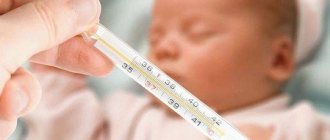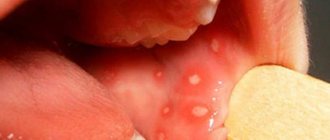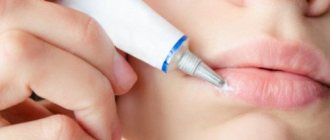Like any other pathological conditions, there can be reasons for a runny nose in infants.
- physiological;
- pathological.
Physiological reasons
The mucous membrane of the nasal cavities immediately after birth, although formed correctly, cannot fully perform its functions and participate in the regulatory mechanisms of the body. In some children, this leads to excessive dryness of the nasal cavity with insufficient secretion production, while in others it leads to excessive secretion - a newborn runny nose.
The functioning of the mucous membrane returns to normal only after reaching 10 months of age. There's no need to worry. This is not dangerous and should go away on its own over time, but the ENT doctors at Dr. Korenchenko’s clinic advise you to see a pediatrician. so as not to miss the beginning of the development of the pathological process behind the imaginary well-being.
Pathological causes
The most common cause is colds, which newborns suffer from especially often. Your own immunity has not yet been formed, and your mother’s is not always effective enough and, moreover, weakens every day. Any infection that goes completely unnoticed in an adult or older child can cause acute respiratory infections and a runny nose in a newborn.
The first symptoms of an acute infectious disease are a rise in temperature and a runny nose in the baby. Later, cough, shortness of breath, and difficulty breathing occur. Sleep and appetite disorders. The child becomes restless, cries, and refuses to eat. Excessive snot in a baby causes irritation of the skin around the nose, on the upper lip, and in the nasolabial folds. At the first appearance of such symptoms, we strongly advise you to immediately contact your pediatrician.
Another common cause of a runny nose in a newborn is an allergic reaction to an external irritant. With age and with the formation of one’s own full-fledged immune defense, this disease can go away on its own, but in infancy, intolerance to any substances is more common than in adults. Irritants can be ordinary household dust, the hair of pets or birds, foreign odors, creams and preparations that are used to treat the baby’s skin, even the smell of the mother and breast milk can provoke snot in a baby.
A relatively uncommon cause of snot in infants is vasomotor rhinitis, a disease associated with impaired blood supply to the nasal mucosa. Only a doctor can make a correct diagnosis.
Treatment
To free the nasal passages, use special microsuctions or a small enema, but only to suck out the secretions, not to rinse. The bulb or enema cannula must be inserted with caution and very shallowly, only 0.5-0.8 cm deep into the nasal passage.
Any folk or witchcraft remedies, potions or manipulations can be performed only after consultation with a doctor. Uncontrolled self-medication can harm the baby. The child is too young to take such risks!
Medicines should be used only as prescribed by a doctor, strictly following his instructions and recommendations. Only a doctor can accurately determine the child’s condition and correctly prescribe medication for treating a runny nose in an infant.
Most commonly prescribed drugs
- Aqua Maris;
- Aqualor Baby;
- Nazol Baby;
- Otrivin Baby;
- Doctor Mom;
- Salin;
- Nazivin for children.
Please note that all of the drugs listed have the prefix “baby” or “children’s”. Adult medications should not be used to treat a runny nose in an infant.
A physiological runny nose in an infant does not require treatment, but only a doctor can determine the absence of pathology. IT IS FORBIDDEN!
- use an enema to rinse the sinuses with fluid injection. A pear and an enema can only be used to suck out snot from a baby, and then only with caution;
- independently prescribe antibacterial and antiviral drugs;
- use vasoconstrictor nasal drops and sprays without consulting your doctor.
Remember! At this age, the baby's health is very fragile. By treating a baby’s runny nose on your own or using recipes from grandmothers you know, instead of improving your health, you can do a lot of harm to him.
It is impossible to leave a runny nose in a baby without treatment. If the process is pathological, the disease will progress and can cause the development of serious and life-threatening complications for the baby.
The difference between a physiological runny nose and cold rhinitis
During the first three months, the newborn adapts to the environment and learns to inhale air through the nose. The glands of the nasopharynx produce a lot of mucus. Its excess is a physiological runny nose. Small discharge without other symptoms is considered normal; it does not worsen the child’s well-being, does not require treatment and goes away on its own within 90 days.
Symptoms of a cold runny nose are:
- The baby often refuses to feed. While eating, he sniffles and whistles.
- Feels hot. The thermometer shows a temperature above 36.6°C.
- The nose does not breathe, air is inhaled through the mouth.
- Sleep patterns are disrupted.
- Sometimes the eyes turn red and watery eyes occur.
- The child sneezes.
- Moodiness and lethargy appear.
It is these signs that indicate the baby’s condition is deteriorating. In this case, medical attention is required. It is worth noting that it is difficult for mothers to distinguish by eye whether a baby has a physiological or pathological runny nose, so the child should be shown to a pediatrician or ENT doctor.
Prevention of runny nose in infants
See also Treatment of ENT diseases Snot in a child Chronic runny nose Treatment of rhinitis
Maintain an optimal microclimate in the room where the child is. The air temperature should be within 18-22 degrees, you cannot leave it naked for a long time, regularly ventilate the room after removing the baby from it, get rid of dust, limit the baby from contact with pets and minimize contact with strangers. Use caution when changing infant formulas when formula-feeding or when introducing supplements and complementary foods into the diet.
Useful tips for mothers
It is extremely important to create favorable conditions at home for the child:
- Achieve the required humidity - at least 60%. To do this, you need to install a humidifier next to the crib, hang wet towels on the radiator, or place containers with liquid next to the heating. In humid air, the baby's mucous membrane will not dry out.
- Monitor the temperature in the room. The optimal value on the thermometer is no more than 22°C.
- Ventilate the room regularly and prevent the air from drying out.
- Carry out wet cleaning daily. You need to wipe the floor, get rid of things on which dust settles. Healthy breathing directly depends on clean air.
- Give your child regular water more often.
Short walks in the fresh air are allowed if the baby’s health does not deteriorate and there is no temperature. It is important to choose clothes according to the weather.
At the ENT CLINIC in Chertanovo, examinations are carried out by otorhinolaryngologists who have extensive experience in treating infants. They will carefully examine the nose, ask parents about the symptoms and behavior of the child, conduct a hardware examination and prescribe therapy that will not harm the newborn.
Clinical manifestations of ARVI and influenza
- nasopharyngitis - nasal congestion, mucous discharge from the nasal passages, discomfort in the throat in the form of soreness, burning; Mucus may drain down the back of the throat, which can cause a wet cough (nasal congestion, mucus discharge and sore throat can cause the child to become restless, including refusing to eat)
- eustacheitis and otitis media - pain in the ears appears, with some forms of otitis there is a decrease in hearing, with otitis media a high temperature also rises
- Laryngitis is manifested by hoarseness of voice, rough cough, but there is no difficulty breathing
- pharyngitis is characterized by a red throat, namely the back wall of the pharynx and palatine arches; the mucous membrane is loose and edematous; mucus may drain down the back of the throat; with pharyngitis, a dry, obsessive cough is common
- tracheitis is a disease that can cause a strong obsessive cough
- croup syndrome (obstructive laryngotracheitis) is characterized by laryngeal stenosis; this condition is a common occurrence among preschool children with ARVI
Do not confuse with pathology
Do not confuse a physiological runny nose with an allergic or inflammatory runny nose. Experienced pediatric ENT doctors in Makhachkala know that usually a newborn does not suffer from allergic rhinitis. Only if an allergen has somehow entered the body, or it happens that the mixture is not suitable. But in this case, as soon as we relieve the allergic process, the runny nose stops.
With an inflammatory nature, the nasal discharge is not transparent, but yellowish, greenish, mixed with blood. Of course, then you need to run to a medical clinic to see a specialist. Because the process can become chronic. You should not get used to vasoconstrictor drops. They do not cure a runny nose, but only relieve the symptom, and besides, they are very easy to get used to. Thus, you will not even notice how your child’s usual physiological runny nose has turned into a chronic form.
Advantages of the Aqualor Baby children's series
To care for the nasal cavity of a newborn, it is advisable to use ready-made preparations, the sterility of which is guaranteed. Aqualor baby drops and spray with a “soft shower” attachment contain natural sea water and do not contain artificial additives, so they can be used without harm from the first days of life both for hygienic procedures and for the treatment of rhinitis of various etiologies.
Natural microelements of sea water stimulate the formation of local immunity, increasing the resistance of the nasal mucosa to microorganisms.
How to rinse a child's nose with saline solution? When using drops, the baby is placed on his back and, without plunging the tip of the bottle deep into the nose, squeeze 2-3 drops into each nostril. When using a spray, the solution is injected into the child's nasal cavity with the body in an upright position, preferably sitting in the arms of an adult (if the child already knows how to sit). In this case, the child's head should be straight and slightly tilted forward. The tip of the balloon is inserted into one of the halves of the nose, pressed on the sprayer and held for several seconds, thus rinsing this half of the nose. Then repeat the procedure with the other half of the nose.
The procedure can precede aspiration or be carried out in the morning and evening as part of daily hygiene. In conditions of dry, heated air, it is advisable to periodically irrigate the nasal passages using a spray.
Causes
During intrauterine development, the respiratory system practically does not function: the fetus is in an aquatic environment and receives oxygen from the mother’s bloodstream through the umbilical cord. After birth, the environment changes dramatically, the respiratory organs come into play, so in the first weeks of life, the glands of the nasal mucosa periodically produce an increased amount of secretion. This phenomenon is protective in nature and is explained by the need to cleanse the upper respiratory tract of bacteria, viruses, mechanical and chemical irritants.
Physiological rhinitis is aggravated by the imperfection of the anatomical structure of the nasal cavity of the newborn. The narrowness and short length of the nasal passages contribute to the stagnation of secretions, which can cause nasal congestion.
In infants from 5 months of age, physiological rhinitis is associated with teething. According to experts, hypersecretion in this case is caused by a rush of blood to the gums and irritation of the mucous membranes of neighboring anatomical structures. Hyperthermia lasting no more than 2 days during this period is due to the production of a large amount of biologically active substances. A dry, infrequent cough is reflexive in nature and is caused by mucus flowing into the throat.
Diagnosis of adenoviral infection
Diagnosing adenovirus infection in most cases is not difficult. The doctor collects anamnesis, conducts an examination, identifies characteristic symptoms and makes a diagnosis based on them. This method is called clinical. It is especially accurate when the disease is widespread, in winter or spring.
In rare cases, a more accurate diagnosis of adenoviruses is required due to the similarity of symptoms to influenza or other, more rare respiratory infections. In this case, laboratory research methods are used, blood is taken for analysis4.
There is an accurate method for detecting adenovirus infection through blood testing.
As additional diagnostic measures, microscopic examinations of the contents of the nose and oropharynx can be carried out to exclude a bacterial infection.
Nasal hygiene
Physiological runny nose does not require correction with medications. At the same time, it is necessary to help the baby get rid of excess mucus, which makes nasal breathing difficult. For this purpose, cotton swabs moistened with saline are used. They are placed in the nasal passages and then removed with twisting movements.
Mechanical or electric aspirators are more effective. The Aqualor Baby aspirator is easy to use. The innovative mucus capture system in the Aqualor Baby aspirator ensures a hygienic procedure - during aspiration, mucus accumulates in a special reservoir. The comfortable mouthpiece has teeth holders, making the suction procedure convenient. The ergonomic body has a special recess for easy grip - the aspirator does not slip out of the hand during the procedure.
A few minutes before the procedure, 2-3 drops of a sterile isotonic solution are instilled into the nose, preferably one based on sea water, such as Aqualor Baby spray or drops. This helps to thin the exudate and dissolve crusts and clots, which increases the effect of aspiration. Usually the procedure is carried out 3-5 times a day.
What is adenovirus infection?
Having found out that adenoviral infection is a type of acute respiratory viral infection, we should consider it in more detail.
The main portal of infection is the upper respiratory tract, and less commonly the conjunctiva of the eyes. It has been noted that the virus multiplies at tremendous speed, easily penetrates the blood from the affected area and spreads further throughout the body. In addition to blood vessels, adenoviruses can use lymph nodes and lymphatic tracts as a road.
The causative agent is a virus containing a DNA molecule. The infection lingers on the mucous membranes of the respiratory system and descends below, affecting the intestines. Quite often, lymphoid tissue is infected. The conjunctiva of the eyes also suggests that adenoviruses may be the culprit2.
ARVI or flu
Despite the fact that influenza is part of the group of acute respiratory viral infections (acute respiratory viral diseases) and their symptoms are very similar, the manifestations of influenza are more pronounced.
If the symptoms of a cold are accompanied by a runny nose, nasal congestion, sore throat, headache, low-grade fever, cough and general malaise, then with the flu there is a sudden onset of illness, high temperature, and fever.
With influenza, the risk of developing bacterial complications, such as bronchitis, pneumonia and otitis media, is many times higher than with regular acute respiratory viral infections.
Treatment of acute respiratory infections in children, effective relief of symptoms
Recommendations on how to treat acute respiratory infections in children are aimed at relieving clinical manifestations associated with the inflammatory reaction.
Recommendations on how to treat acute respiratory infections in children are aimed at relieving clinical manifestations associated with the inflammatory reaction.
- a diet rich in vitamins;
- drinking plenty of water;
- antipyretic drugs.
Locally, symptoms are relieved by the following means:
- for nasal congestion - with vasoconstrictor drops;
- if the throat is affected - with sprays, local antiseptics, gargles;
- to relieve a wet cough - with expectorants;
- for dry cough - antitussives. Source: T.A. Samsygina Modern treatment of acute respiratory diseases in children // Pediatrics, 2013, No. 3, pp. 38-42
Inhalations and physiotherapy may also be prescribed.
Antibiotic treatment for acute respiratory disease is prescribed to children when the causative agent is a bacterial infection; only a doctor should give clinical recommendations, select the drug and dosage. If a child is prescribed an antibiotic for the flu, it is necessary to relieve complications that arise from bacterial damage (for example, pneumonia). In general, antibacterial drugs are powerless against viruses.
Doctors recommend avoiding antibiotics for uncomplicated respiratory viral infections. Their use is not justified even with mucopurulent runny nose lasting less than 2 weeks. Source: Seto WH, Conly JM, Pessoa-Silva CL et al Infection prevention and control measures for acute respiratory infections in healthcare settings: an update // East Mediterr Health J., 2013, i9 (Suppl. i), p. 39-47
Signs of a bacterial infection for which antibiotics are indicated:
- anaerobic sore throat;
- purulent processes;
- acute tonsillitis when group A streptococcus is detected;
- sinusitis, if clinical changes persist in the sinuses after 2 weeks from the onset of the disease;
- acute otitis media;
- pneumonia;
- chlamydia and mycoplasmosis (respiratory form);
- bronchitis caused by mycoplasma (mycoplasma bronchitis).
The child is required to have bed rest
until body temperature normalizes,
eat a balanced diet, take multivitamins
. You can gargle with decoctions of medicinal herbs, infusions, and antiseptic solutions. If the body temperature is normal, then the following will be useful: dry heat on the lower back and feet, hot foot baths.









